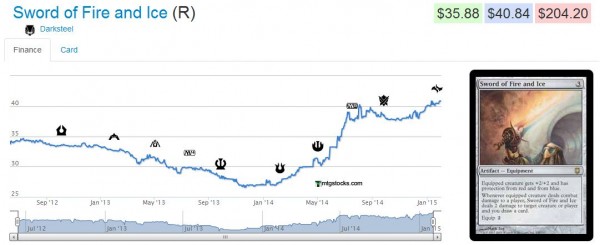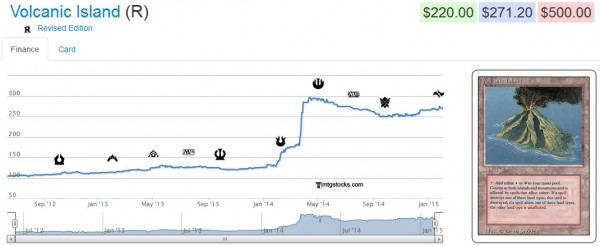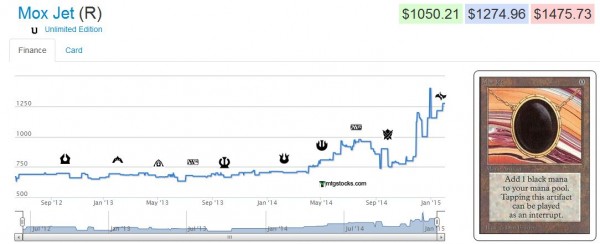Are you a Quiet Speculation member?
If not, now is a perfect time to join up! Our powerful tools, breaking-news analysis, and exclusive Discord channel will make sure you stay up to date and ahead of the curve.
Last weekend I indulged myself in a rare experience: I battled at the Star City Games Legacy Open in Indianapolis! After experiencing a bumpy start, I surprised even myself as I managed to string together a few consecutive victories. As it turns out, playing AnT is like riding a bike – although I only use the deck a couple times a year, I am able to quickly re-familiarize myself with all the nuisances it brings.
But this isn’t a strategy column. You’re reading this for the financial aspects. Fortunately I have a few key financial observations I want to share from this event. And while I was a bit disappointed with the measly three vendors available to sell to at the event, I still managed to pick up a couple useful tidbits of info.
Amazon Say What?
When you initiate trades with someone, what’s the typical source of data you use for pricing? Star City Games prices? TCG Mid or Low pricing? Maybe cash prices, if the trade calls for it?
These are all reasonable options. But for some reason, one vendor at the SCG Open wasn’t really interested in those websites. Instead, they used Amazon for pricing.
Amazon??? Really???
Apparently the vendor primarily sells on Amazon, and so they used Amazon.com pricing to estimate their buy prices. I’m pretty sure Amazon prices can be weirdly high sometimes, so that was fine by me!
One example that leaps out in my mind was foil Summoning Trap.
A couple months ago I picked up a couple foil and nonfoil copies after reading about how many QS Insiders felt it was underpriced. At $1-$2 each, grabbing a few SP to MP foils felt like a relatively low risk.
As it turns out, foil Summoning Trap starts at around $10 on Amazon.com. Naturally the vendor offered roughly 50% of this price, or about $5, for my copies. Not too bad, considering TCG Low is $3.59 and the top buy price on Trader Tools for foils is around $3. Plus, with my copies being SP to MP, the deal was sweet.
It is worth noting that foil Summoning Trap has been on quite the run of late. I’ll point this out now since I just realized the jump recently myself.
All in all I sold through a seemingly random array of cards that were just a bit more expensive on Amazon, leading to favorable buy prices. Nothing broken, mind you. In fact when the dealer observed there were zero foil Gilt-Leaf Archdruid in stock, they refused to offer me a price. If only I knew someone who could have listed a copy at $20 before I approached the booth!
The other noteworthy sell I made was my SP Sword of Fire and Ice, for $30. The card has bounced lately, but that $30 price tag is just a few bucks below TCG Low. This was a deal I could not pass up.
The Real Story
While I had never before worked with a dealer who based their prices on Amazon, this was not really the MTG finance headline of the Legacy Open. Unfortunately there was a negative story which stirred the room.
Someone brought a bunch of counterfeit dual lands to the Open and managed to trade about “$2,000” worth to an unsuspecting trader. It did not take long for savvy speculators and experienced players to point out the horrid truth: the poor trader gave up a couple thousand dollars in cards and was left with a stack of counterfeits.
This kind of thing is terrible for the game of Magic. The lack of integrity really hurts because it discourages players from pursuing the game. But is this bad for prices overall?
Allow me to pose a thesis.
We all know there have been counterfeits of Power for years now. I wouldn’t touch a piece of Power unless I trust the seller – that means they either must be a major vendor or they need thousands of feedback. Otherwise the risk of getting stuck with a fake is just too serious.
Nowadays the prices of dual lands are starting to become as expensive as Power was a few years ago. Volcanic Island and Underground Sea are even knocking on the door of $300 – this is more than what I paid the first time I picked up a Mox!
Let’s follow this string of logic further and see where it gets us. If we accept the premise that players who want Power are more likely to acquire from trusted vendors, then those vendors are more likely to sell out of stock. After this happens enough times, they are obligated to increase their buy prices so they can bring new copies in. And with their trained and experienced staff, they can be confident they’ll successfully avoid counterfeits.
This buy price increase can sometimes be gradual, but it generally moves in only one direction: up. Of course, there are also the instances where a major vendor like Star City Games suddenly jacks up their buy prices out of the blue, causing an actual spike in the Power market.
This is exactly what happened recently.
Now we are seeing significantly higher prices for Power – prices that are likely here to stay.
So what happens now that dual lands are also under extreme scrutiny as more counterfeits enter the market? I don’t know about you, but I am going to make 100% sure a dual land is authentic before acquiring.
That may mean I request a trusted third party verification of authenticity. Or it may mean I only pick up duals from friends or trustworthy vendors. Either way, the days of winning that lucky auction for a NM Tropical Island for $110 from a seller with 2 feedback are long gone. I won’t take such risks anymore.
If others follow suit, what do you think will happen? I propose that dealers will start to have a tougher time keeping duals in stock. They will continue to acquire copies by scrutinizing every one closely, as they always do. But if demand for duals from vendors increases because players want assurance of authenticity, then maybe sellers won’t be able to keep stock so easily.
This could lead to an increase in buy prices, leading to a spike in overall values.
Now don’t get me wrong – there are a ton more dual lands in existence than there are pieces of Power. I get it. But I don’t think that takes away from the possible trend. Price increases may be more gradual, but I still think they will happen.
And with Spring right around the corner, I also anticipate upward pressure from the cyclical nature of Magic. Prices tend to rise that time of year and I don’t expect 2015 to be an exception.
Therefore I must maintain a buy recommendation on most dual lands. Spring time will bring the next bounce (hopefully), and I don’t see counterfeits destroying this secondary market. Not as long as people can tell the difference between what’s fake and what’s real. And should history repeat itself, I actually see counterfeits causing an increase in prices. As long as Legacy stays healthy and demand remains steady, this is my prediction.
And judging by the fact that in nine rounds of Legacy I did not battle against the same deck twice, I’m fairly confident the format is as robust as ever!
…
Sigbits
- I especially like Tropical Island right now. With the banning of Treasure Cruise, players are more likely to revert back to classic builds of Delver decks, which often came in the form of RUG or BUG. This bodes well for the blue-green dual land. Star City Games has a $219.99 price tag for NM copies and $179.99 for MP. (Tundra is the same price!) Their stock is reasonable with 69 total Revised copies in stock, but I suspect the numbers to dwindle in the coming months. Perhaps I should track it for you here?
- One of my losses last weekend was to Omni-Tell, which wins the game by casting a copy of Enter the Infinite for free. While picking up non-foil copies may be unexciting, it’s definitely noteworthy that SCG is out of foil stock with a price tag of $7.99. I expect this to go higher.
- I can’t harp on dual lands enough. I really think we bottomed here. Volcanic Island is the most likely candidate to bump higher next. Star City Games sells NM copies for $299.99 and MP copies for $249.99. The total number of Revised copies they have in stock: nine.









I had posted in the forums last year after the Chinese counterfeits came to light that a 3rd party deal broker for expensive cards esp. the ones that are known to be counterfeited might be a good business niche. Would add to cost / shipping but seems like we are getting closer to that point where it will be worth it.
One could maybe argue that this is offered by grading services.
Agree but not interested in getting cards slabbed. Need to have faster turnaround times.
Fair enough, it is possible to get them out of grading cases ;).
Some risk of damage there though. What would slow the counterfeiters down some is for WoTC and/or SCG to have free screening at large events.
I love this idea! Assuming the quantity of cards isn’t astronomical, I think it’d be a terrific service to offer to people who participate in events. This motivates people who show up to sign up and play and also cracks down some on counterfeits. Thanks for commenting!
Now, who can relay this to Wizards and make it happen? 🙂
Maybe tweet to Helene? May have to charge a little though.
The second Wizards rolls out a “get your cards checked” booth, player confidence comes crashing down. That is not the image of confidence they want to project.